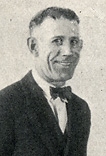 Erle Armstrong was a leading Class A racing star in the 1910s who later went on to become the beloved patriarch of Indian Motocycle Company. He worked for Indian, either directly or indirectly, for most of the 50-year history of the company. He was one of the diehard loyalists who tried in vain to keep the company going in its final days in the mid 1950s. Armstrong was also a Vaudevillian motorcycle stunt rider, building a special "Silodrome" and traveling with various riding partners, putting on shows in theaters across the country.
Erle Armstrong was a leading Class A racing star in the 1910s who later went on to become the beloved patriarch of Indian Motocycle Company. He worked for Indian, either directly or indirectly, for most of the 50-year history of the company. He was one of the diehard loyalists who tried in vain to keep the company going in its final days in the mid 1950s. Armstrong was also a Vaudevillian motorcycle stunt rider, building a special "Silodrome" and traveling with various riding partners, putting on shows in theaters across the country.
Born in southern Illinois on April 5, 1888, Armstrong was the son of a mining engineer and his family moved to Colorado when he was 10. Armstrong became Colorado State bicycling champion at the age of 16. It was about this time that he became interested in motorcycles. His purchased his first machine, an Orient, in 1904.
In 1906, Armstrong took a job making 30 cents per hour as a mechanic for a Denver Indian dealership. He worked 10 hours a day, six days a week, to be able to afford to race. Armstrong became one of the best racers in the Denver area. He cut his teeth racing in Denver on the board track at Tuileries Park. He won his first race in 1906 and was dubbed "Red" for his brightly colored hair.
In 1907, a famous incident happened to Armstrong. He was racing in Denver and a girl who felt Erle had scorned her was determined to take revenge on him. She stood trackside waiting for the motorbikes to pass. When Erle came by the girl threw a broomstick into Erle's front wheel and sent him crashing to the ground.
A year later, Earl gave up the risky single life when he met and married the former Maude Miller of Denver.
By 1909, Armstrong built enough of a reputation to become a factory rider for Indian. This was the beginning of a nearly life-long association with the Springfield, Massachusetts-based manufacturer. Armstrong raced for Indian in many of the top races of the day, such as the Dodge City 300, but most of his fame was earned on the numerous board tracks across the country.
His biggest victory came on the boards in a 300-mile championship race in Tacoma, Washington, in August of 1915. He won that race in record-breaking time over a star-studded field that included Harley-Davidson rider Otto Walker and fellow Indian star Don Johns.
By 1915, Armstrong gave up the dangerous board-track racing circuit and began a short-lived career as a stunt rider. Armstrong built a special "Silodrome," a large barrel built with wood slats so that spectators could watch from any angle. Setting up the Silodrome in theaters and dubbing the show "The Whirl of Death," Armstrong and another rider would ride in the small cylinder doing various stunts. The act became so popular that Armstrong was asked to perform the show (with a much larger
cylinder) during the Panama-Pacific Exhibition held in San Francisco in 1915. His wife often rode in the show on a specially-built tandem motorcycle.
As World War I approached, Armstrong took a full-time position with Indian. His first assignment for the company was running an Army motorcycle training facility at Fort Sill, Oklahoma. Armstrong would continue to do military and police training for Indian throughout most of the 1920s.
In 1919, Armstrong was a sidecar passenger in an ill-fated cross-country record attempt with the legendary Cannonball Baker. The two were stopped in the Midwest by heavy rains that turned the roads into muddy quagmires.
Armstrong opened an Indian dealership in Worcester, Massachusetts, in 1927, and ran it until 1940. During this period, he formed the Armstrong Roamers Motorcycle Club and served as president of the New England Motorcycle Dealers Association. The club put on many AMA-sanctioned events, including races. Armstrong entered his final race in 1931 at the age of 43. He also captained a motorcycle polo team in the early 1930s. One of his teammates was legendary New England racer Woodsie Castonguay.
Tragedy struck the Armstrong family in 1930 when Erle's oldest son Bob, an AMA hillclimbing champion, drowned in a boating accident.
After closing his dealership in 1940, Armstrong became production manager for Indian. He remained with the company until its final days. A fervent Indian loyalist, Armstrong, along with several other Indian enthusiasts, tried in vain to keep Indian alive.
In retirement Armstrong, nicknamed Pop, kept the history of Indian and the old Class A racing days alive. He frequently gave talks on his racing days to various motorcycling enthusiast groups.
Armstrong failed to recover from a diabetic coma and died on April 29, 1978, fittingly in Springfield, the home of his beloved Indian.